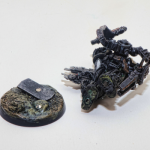How Magnets Can Enhance D&D Gameplay in the 2024 Rule Update
If you’ve ever lost track of which mini was Grappled or accidentally knocked a spell template out of place, you’re not alone. With the 2024 revision of Dungeons & Dragons (D&D) placing greater emphasis on visual clarity, quicker combat pacing, and deeper player immersion, it’s the perfect time to explore how magnets can enhance D&D gameplay.
In a recent chat with miniature artist Master Builder Etiquette (Instagram @master_builder_etiquette), we talked about how magnets are a genuine tool for Dungeon Masters (DMs) and players looking to level up the physical experience at the table. From condition tracking to terrain building, magnets for D&D gameplay offer a low-cost, high-impact way to create a more immersive and organized session.
Six clever ways to bring magnetic magic to your next campaign
Magnetic Condition Trackers for Minis
Visual clarity is extremely important with conditions like Frightened, Grappled, and Exhaustion taking center stage in the new rules (hello, 10-level exhaustion system). Instead of cluttering the board with tokens or forgetting which mini is under which spell effect, try attaching magnetic condition indicators directly to the base of your minis.
DIY tips:
- Use small neodymium disc magnets (such as 1/8” x 1/16" or 1/4” x 1/16") embedded in plastic rings or painted markers.
- Paint or label snap-on rings for each condition: Stunned, Invisible, Charmed, etc.
- Stack numbered discs for exhaustion levels, or swap in wild shape forms without switching minis.
Bonus: These can double as status rings for familiars, summoned creatures, or constructs.
Modular Magnetic Dungeon Tiles
The updated Dungeon Master’s Guide in 2024 encourages DMs to lean into modular storytelling and creative encounter spaces. Magnetic dungeon tiles make it easy to build dungeons, towers, and traps that hold together without shifting mid-combat. With this setup, your table becomes a story tool, not just a backdrop.
What to try:
- Attach adhesive-backed magnets to the underside of your dungeon tiles, and place a sheet of galvanized steel under your playmat or table for secure placement.
- Use stronger block magnets (like ½" x ¼" x ⅛") in modular terrain pieces like bridges, staircases, or trap doors that need to connect and disconnect reliably.
- Hide thin magnetic latches behind false walls, secret doors, or “click-to-open” puzzle panels.
Customizable Miniatures with Swappable Gear
The new Player’s Handbook introduces expanded equipment, forms, and species customization, making it harder to represent every possible state with a single mini. That’s where magnets come in:
- Embed tiny disc magnets in your mini’s hands or base to swap out weapons, spell effects, or equipment.
- Use ring magnets for modular limbs, heads, or summoned constructs.
This approach is perfect for druids in wild shape, Warlocks with summoned blades, or anyone who transforms mid-combat.
Magnetic Spell Templates & AoE Effects
Spell effects and templates can cause serious tabletop clutter, especially when using area-of-effect spells like Fireball, Web, or Spirit Guardians. Magnetic templates solve that issue by locking into place without damaging terrain or minis.
DIY your own:
- Use transparent acrylic templates with embedded magnets that snap to a metal grid or gaming board.
- Color-code overlays to indicate spell duration or intensity. Magnets can easily be painted to create a color-coded system.
- Create origin-point discs that “click” to a mini’s base to mark a spell’s caster.
Magnetic Initiative Trackers
Combat moves fast with the 2024 pacing adjustments, so a clean initiative tracker system helps everyone stay engaged. Magnetic trackers are easy to update, rearrange, and read at a glance. You’ll spend less time flipping through notes and more time telling a great story.
Try this:
- Create a vertical magnetic board and attach labeled discs or tiles for each combatant.
- Use flexible magnetic strips on a dry erase board to add hit points, conditions, or turn reminders.
- Rearrange order quickly when players delay, ready, or fall unconscious.
Puzzles & Props That Click
With mechanical puzzle design now supported in the new Dungeon Master’s Guide, physical props make exploration meaningful.
Incorporate magnets into:
- Puzzle boxes with hidden magnetic latches
- Rune stones that “snap” into place only when arranged correctly
- Dungeon doors that unlock when the right sequence of magnetic sigils is used
Use ring magnets or disc magnets to create real feedback—clicks, pulls, and resistance—that mimic the in-game tension of solving a magical puzzle or unlocking an ancient mechanism.
Magnets may not be listed in the Player’s Handbook, but they might as well be a magic item for your table. From tracking combat effects to building modular terrain, magnets for D&D gameplay allow players and DMs to adapt, customize, and enhance their sessions with minimal effort and maximum creativity.
Want to build your own D&D magnet kit?
Explore disc, ring, and adhesive-backed magnets at ApexMagnets.com to get started. And be sure to read more about using magnets for your D&D gameplay on our latest blog post.
We have a vast selection of magnets, so look through them to find the perfect options for your specific needs. Finally, subscribe to our monthly newsletter! You’ll be among the first to receive notifications about our latest blogs and discounts for our latest magnet deals.
If you need additional help learning how magnets can enhance D&D gameplay or have general magnet questions, contact us!
Safety Warning: Children should not be allowed to play with neodymium magnets as they can be dangerous. Small magnets pose a choking hazard and should never be swallowed or inserted into any part of the body.
Magnets can be dangerous. Neodymium magnets, especially, must be handled with care to avoid personal injury and damage to the magnets. Fingers and other body parts can get severely pinched between two attracting magnets. Bones can be broken by larger magnets. Visit our Magnet Safety page to learn more.

